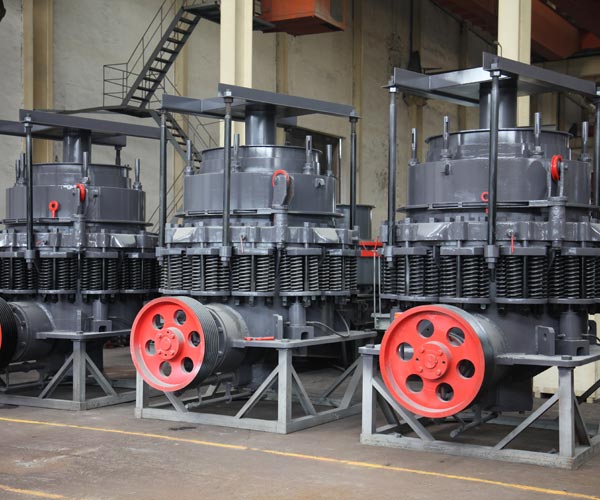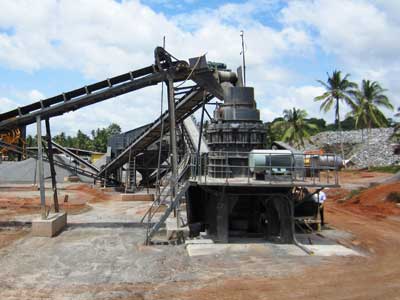
Cone crushers are essential equipment in the rock crushing industry, widely used in mining, construction, and other sectors for their high efficiency and versatility. As technology evolves, new types of cone crushers emerge to cater to specific demands and applications.
24 Online Service
Cone crushers are essential equipment in the rock crushing industry, widely used in mining, construction, and other sectors for their high efficiency and versatility. As technology evolves, new types of cone crushers emerge to cater to specific demands and applications.

The HST cone crusher, also known as the standard cone crusher, was the first of its kind. This cone crusher is known for its simple design, robust construction, and efficient performance. It consists of a main shaft, an eccentric sleeve, a crushing cone, and a concave. The crushing process takes place as the rock material is compressed between the cone and concave, breaking it into smaller pieces.
HST cone crushers are best suited for secondary and tertiary crushing in mining and aggregate production. They are not typically recommended for fine crushing due to their larger minimum output size.

The HPT hydraulic cone crusher is an advanced version of the HST cone crusher, with the primary difference being the incorporation of hydraulic systems for adjusting the crusher settings. The HPT hydraulic cone crusher features an automatic overload protection mechanism, which prevents damage to the equipment by releasing the crushing cavity if the material becomes too hard or uncrushable.
Hydraulic cone crushers are ideal for both secondary and tertiary crushing, and they can handle various rock types, including hard and abrasive materials. Their advanced features make them a popular choice in mining, construction, and recycling applications.

The spring cone crusher operates on a similar principle as the HST cone crusher but incorporates a spring safety system. This system allows the release of uncrushable materials by expanding the spring, which returns to its original position once the obstacle is cleared. This mechanism ensures that the crusher does not suffer any damage during the crushing process.
Spring cone crushers are ideal for secondary and tertiary crushing in applications where the material is not excessively hard or abrasive. They are commonly used in the mining, construction, and cement industries.
The compound cone crusher is a hybrid version that combines the features of the and hydraulic cone crushers. It incorporates a hydraulic system for adjusting the crusher settings and a spring safety system for overload protection. The compound cone crusher offers the benefits of both types, making it suitable for a wide range of applications.
Compound cone crushers are a popular choice for mining, construction, and aggregate processing applications. Their ability to handle different rock types and produce a wide range of output sizes makes them a versatile and efficient solution for rock crushing.
Cone crushers are essential pieces of equipment in rock crushing, offering high efficiency and versatility in various applications. A common question when considering the use of cone crushers is whether they are suitable for primary or secondary crushing.
Before discussing the role of cone crushers in primary and secondary crushing, it is essential to understand the distinction between the two.
Primary crushing involves the initial reduction of raw materials, often from a quarry or mining site, to a manageable size for further processing. The goal is to reduce large rocks into smaller ones, typically in the range of 6 to 10 inches. The output material from primary crushing is then fed into secondary crushers.
Secondary crushing involves taking the output from primary crushing and reducing it further to achieve a specific size or shape. This stage is crucial to producing the desired product, whether it is for use in construction, road building, or other applications. The output material from secondary crushing is typically in the range of 1 to 4 inches.

While cone crushers are versatile and can adapt to various crushing requirements, they are not typically the first choice for primary crushing operations. The primary reason is their relatively high minimum output size.
Cone crushers are designed to crush rocks by compressing them between the mantle and concave, which results in a minimum output size that is larger than what is typically desired in primary crushing.
Jaw crushers and gyratory crushers are more suitable for primary crushing due to their ability to achieve a smaller output size. They can handle large, irregularly shaped rocks and are designed to withstand the intense pressure and force required during primary crushing.
However, in some cases, cone crushers can be used as primary crushers when the material to be processed is not overly large or hard. For example, in small-scale mining or quarries with limited space and production requirements, a cone crusher may be a feasible option for primary crushing.

Cone crushers excel in secondary crushing applications due to their adaptability, efficiency, and ability to produce a wide range of output sizes.
Their design allows them to take the output from primary crushing and reduce it further to achieve the desired size and shape for the end product. Cone crushers are especially suitable for secondary crushing because:
Cone crushers are highly adaptable machines that can be adjusted to produce various output sizes. This makes them an excellent choice for secondary rock crushing, where the goal is to achieve a specific size and shape for the end product.
Cone crushers are designed to consume less energy per ton of crushed material, resulting in lower operating costs and higher productivity. This is particularly important in secondary rock crushing, where the focus is on achieving the desired output size while maximizing efficiency.
Cone crushers are built with robust construction, ensuring a long service life and low maintenance requirements. This makes them a reliable choice for secondary rock crushing, where downtime and equipment failure can be costly.
Modern cone crushers often feature advanced automation systems that improve safety, performance, and monitoring capabilities. These features are particularly beneficial in secondary rock crushing, where consistent output size and efficient operation are crucial.
Cone crushers are commonly used in secondary crushing stages in the mining, construction, and aggregate industries. They can handle a wide range of rock types, including hard and abrasive materials.
While cone crushers are not typically the first choice for primary crushing, they excel in secondary crushing applications. Their versatility, efficiency, and durability make them a popular choice for reducing the output from primary crushers to the desired size and shape for the end product.
It is essential to carefully consider the specific requirements of the application and the characteristics of the material being processed when selecting the most suitable crushing equipment.

Cone crushers play a crucial role in rock crushing, providing high efficiency and versatility in a wide range of applications. One of the essential factors to consider when selecting a cone crusher for a particular operation is the feed size, which refers to the size of the rocks that can be fed into the crusher.
Feed size, also known as the maximum particle size or top size, refers to the largest dimension of the rock material that can be introduced into the crushing chamber of a cone crusher. Feed size is a critical parameter because it determines the capacity and efficiency of the crusher, as well as the output size and shape of the crushed material.
The feed size directly influences the performance and efficiency of cone crushers in several ways:
The relationship between feed size and crushing efficiency is complex and depends on several factors, including the crusher type, crushing chamber design, and operational parameters. However, some general observations can be made:
To achieve optimal crushing efficiency and performance, it is essential to select a cone crusher that can accommodate the feed size of the material to be processed. Some tips for choosing the right cone crusher based on feed size include:

Cone crushers are versatile and efficient machines that play a crucial role in various industries, including mining, construction, and aggregate production. They are especially suited for secondary rock crushing, where the primary objective is to further reduce the size of the rocks produced by primary crushing equipment.
Secondary rock crushing is the process of taking the output from primary crushing and reducing it to a more refined and uniform size. This stage is essential for producing the desired product, whether it is for use in construction, road building, or other applications. The output material from secondary crushing is typically in the range of 1 to 4 inches.
Cone crushers are widely used in secondary rock crushing applications across various industries, including:
To achieve optimal performance and efficiency in secondary rock crushing, it is essential to select the right cone crusher for the specific application. Factors to consider when selecting a cone crusher for secondary rock crushing include:
Our Projects
Copyright © ZENITH, All Right Reserved.
